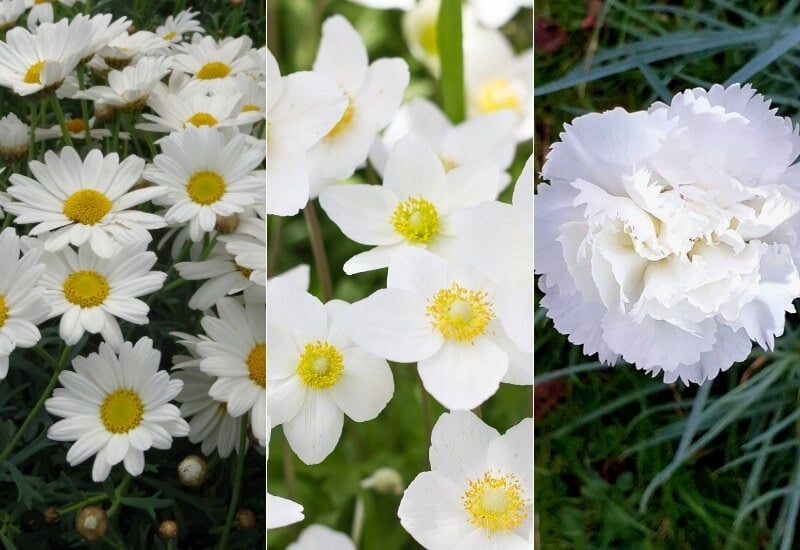
White flowers have a special feel to them, a strange mystique that goes with the candor of this color. Perennial flowers add to this the fact that they come back year on year.
White perennial flowers can lighten up the color scheme of a bed or border, and add scattered snowflakes in wild meadows. Actually, this is such a loved color with gardeners that white gardens have been popular for centuries. Maybe this is what you had in mind?
White is one of the most common colors in perennial flowers. The choice is huge and it goes from large trees like apples, to their relative, the rose, to small bulbous plants. While the color is the same though, the effect in your garden and care they need varies a lot.
From this wide range of white flowering perennials we have selected some of the best for your garden based on their aesthetic value but also availability, adaptability and how easy they are to grow. This article will lay them all out to you with great pictures but also handy tips.
White Perennials: The Brightest Color In The Garden
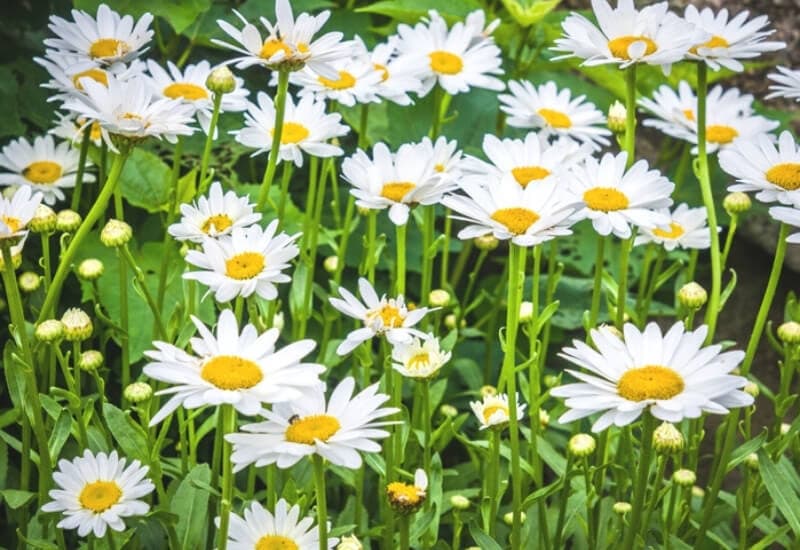
How can you use white in your garden though? White as a color expresses peace and innocence. But it also brings a lot of light and lightness to your garden. So, you can use it in many ways and here are some tips for you:
And you can do all this choosing from the beautiful perennials you ate going to meet right now!
15 Beautiful White Flowering Perennials for Your Garden
Whichever the reason that has brought you to look for white perennials, here is a list that will satisfy your needs. So, whether you want to soften a hedge, scatter a flower bed with some light or you have a whole white garden planned,
Here are 15 of our favorite white perennial flowers to add a bounty of snowy blooms in your garden:
1. English rose ‘Claire Austin’
2. Gardenia ‘Aimee’
3. Jasmine
4. Sword lily ‘White Prosperity’
5. Nyman’s hybrid eucryphia
6. White ginger lily
7. Caribbean spider lily
8. Oriental lily ‘Casa Bianca’
9. Canna lily ‘Ambassadour’
10. ‘Mrs Sinkins’ pink
11. African lily ‘Polar Ice’ and ‘Albus’
12. Peruvian lily ‘Antarctica’
13. Japanese anemone ‘Wild Swan’
14. Columbine ‘Songbird Dove’
15. Water arum
All white, all perennials and all beautiful, these flowers cover a range of shapes, sizes and growing needs to make sure that you will find one that suits your needs. And talking about needs and the craft of the gardener…
1. English Rose ‘Claire Austin’ (Rosa ‘Claire Austin’)
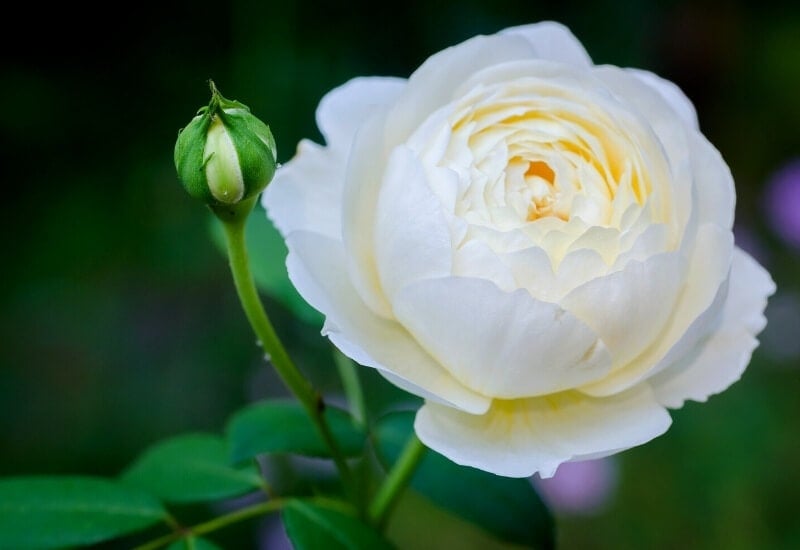
A classical English rose with cup shaped flowers, ‘Claire Austin’ is a cultivar by David Austin. It has large flowers that can reach 3.5 inches across (9 cm) and an amazing number of petals that give it a full, almost globular shape. In fact, each white flower can have up to 120 petals!
This climbing rose will bring a touch of “traditional old world”, not without a romantic hint, to your fences, gazebos, trellises arbors and pergolas. But don’t be deceived by the “old fashioned” look of this repeat bloomer: it is a strong and vigorous plant, and adaptable to fairly cold climates and urban areas.
2. Gardenia ‘Aimee’ (Gardenia Jasminoides ‘Aimee’)
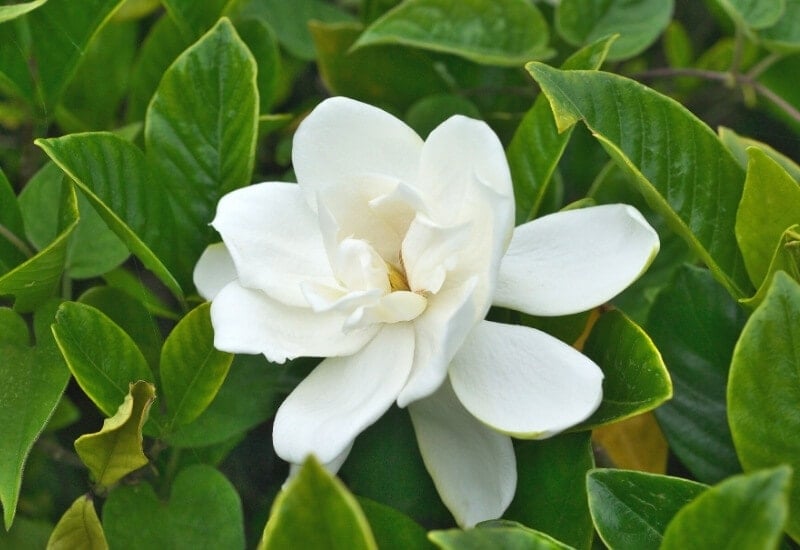
Talking of white perennial flowers we could not miss an iconic classic: gardenia. But the ‘Aimee’ cultivar adds huge blooms to the classical shape of this perennial flower and the sweet scent you can find in other gardenias. In fact, each head can be 5 inches wide, which is 12 cm!
This is a splendid shrub that will bloom from late spring to summer. Excellent as a standalone plant but also within borders and hedges, this plant loves acidic soil. You are lucky though; if your soil is alkaline, it adapts well to large containers, so you can also grow it in patios and terraces.
3. Jasmine (Jasminum Officinale)
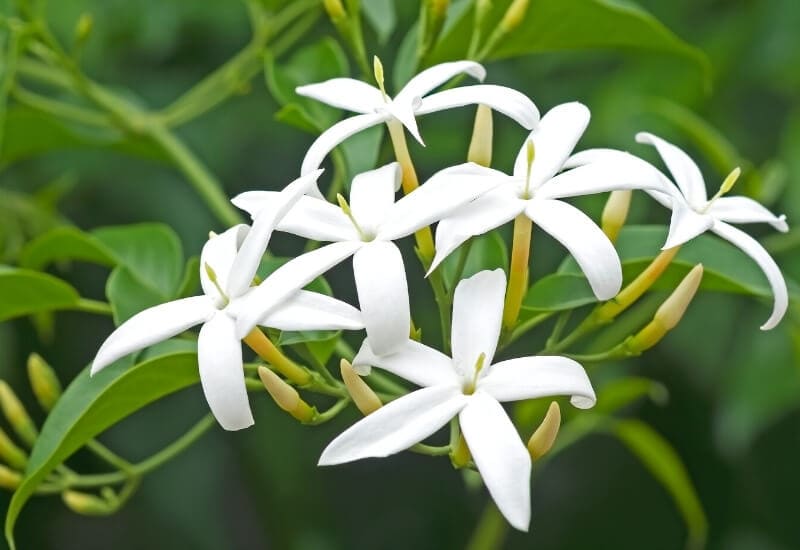
You cannot miss a jasmine plant in a garden… When it’s in bloom, its white wall, or waterfall of flowers is stunning, but maybe what strikes you most is the intoxicating yet heavenly sweet scent you can smell from a distance.
This is also a fast growing perennial and and a semi-evergreen, which means that in warm climates, it will never shed its beautiful, glossy dark green foliage.
If you want to paint a wall white with flowers, or turn your fence into a blooming cloud, or cover your pergola with a scented white cloud, jasmine is by far your best choice. Then, butterflies and bees will come in hordes to add their own colors to your garden.
4. Sword Lily ‘White Prosperity’ (Gladiolus ‘White Prosperity’)
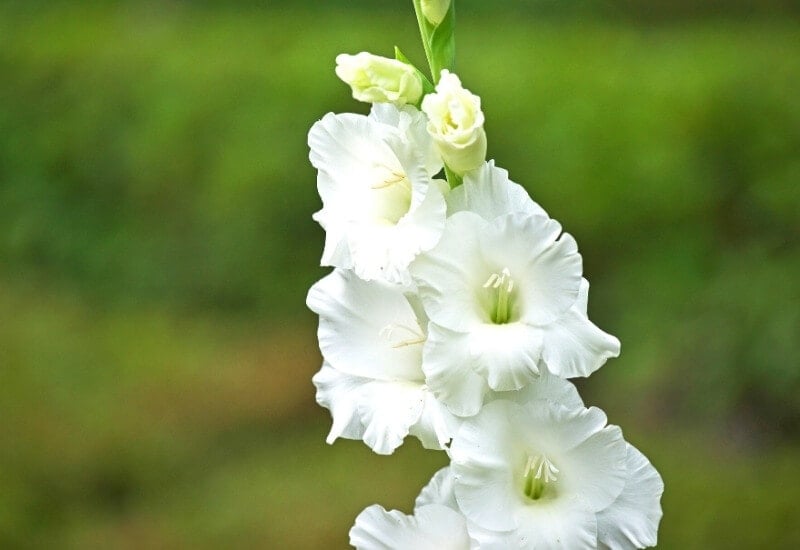
Sword lilies are known for their lively colors, and maybe you have never seen a white one. But ‘White Prosperity’ is literally snow white. This generous bulbous (it has corms) perennial will make an impact on any visitor to your garden just because of the unusual color of its large flowers. In fact, the long spikes will have single heads that can be 4 inches in diameter, or 10 cm!
This showy flowering plant is outstanding for elegant flower beds with a contemporary feel, containers, urban and gravel gardens, but in the right mix it will look great in traditional gardens too. Of course, it is one of the most popular cut flowers thanks to its long lasting blooms.
5. Nyman’s Hybrid Eucryphia (Eucryphia X Nimansensis ‘Nymansay’)
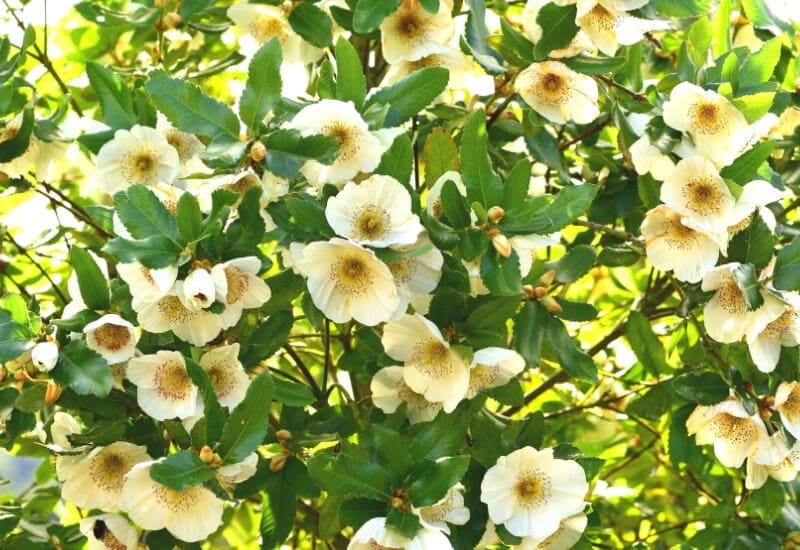
Do you need a large tree with showy white flowers that will last longer than the average fruit tree? Add beautiful glossy and dented leaves that look slightly like those of holly shrubs and you get this lovely award winning hybrid from two Chilean trees.
This winner of the Award of Garden Merit of the Royal Horticultural Society will fill with individual, well spaced cup shaped flowers with board petals with a paper texture, vaguely reminiscent of hibiscus, though the center is marked by a crown of yellow stamens. Each will reach 3 inches in diameter (7 cm). Snd they are fragrant too!
6. White Ginger Lily (Hedychium Coronarium)
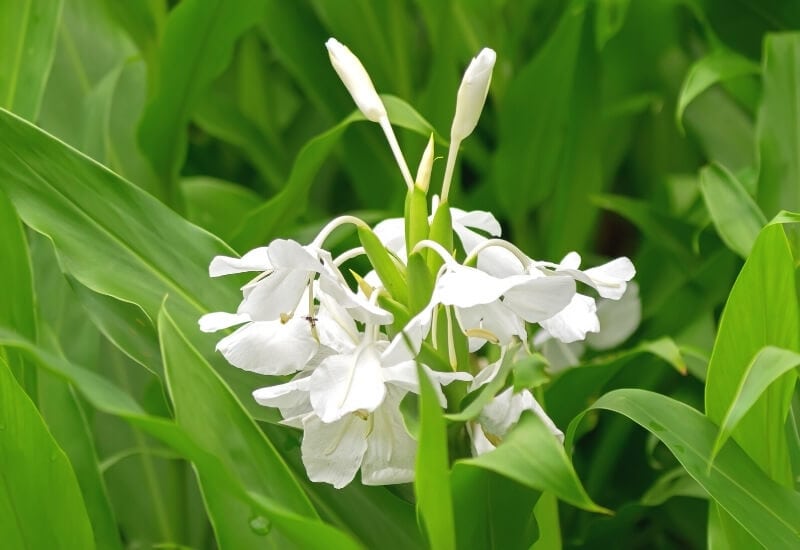
Do you want to play with white and a very exotic shape? Maybe your flower beds, patio or containers need a tropical look? This perennial has all the charisma of tropical forest plants, but it is also fairly hardy.
With very fragrant butterfly shaped flowers, fleshy leaves (a bit orchid like, but wavy), it does not matter if each flower only lasts one day… White ginger lily will produce hundreds of them over a period of two months. That’s plenty even for the most demanding garden!
The flowers are also large, 8 inches across (20 cm) and they come on long stems.
Once the flowers have gone, the leaves have incredible decorative beauty too. This is an ideal addition to tropical gardens or flower beds that need both some candor and some character. It is also good as a pond side or river side plant, but maybe its best place is centerstage in a beautiful container on a patio or terrace.
This perennial is a winner of the Award of Garden Merit by the Royal Horticultural Society.
7. Caribbean Spider Lily (Hymenocallis Caribaea ‘Varoegata’)
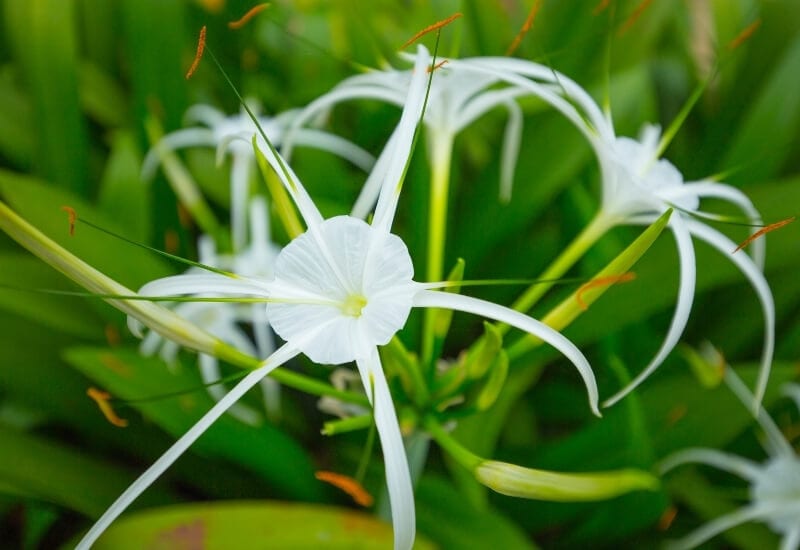
For smaller beds and pots, you can add an exotic and elegant white touch with Caribbean spider lily.
This beauty has a central crown of joint petals that look a bit like a round and dented white star. But it also has six very long and thin pointed white petals that look a bit like spider legs to some, though to me they look more like snow colored Sun rays…
Add to this the long and pointed leaves with central green stripes coasted by cream ones and you can see how this original and playful bulbous perennial can really bring an interesting element to flower beds or become the protagonist in containers.
8. Oriental Lily ‘Casa Blanca’ (Lilium ‘Casa Blanca’)
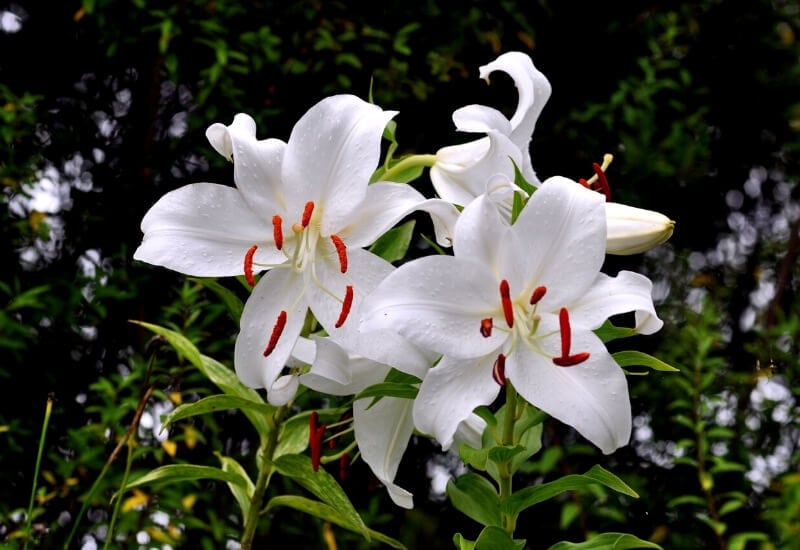
For a classical lily with the whitest flowers ever, oriental lily ‘Casa Blanca’ is nigh on unbeatable. This bulbous perennial has all the charm, the elegance and the sunny showy flower of any other lily, but it is so white that it it almost looks like icing sugar.
Every stem will produce between 6 and 8 large flowers with the typical copper color pollen laden anthers. Despite its oriental look, it is quite cold hardy, and you can grow it in full soil even in many parts of Canada.
It won the Royal Horticultural Society’s Award of Garden Merit back in 1993 and it is excellent for flower beds in particular, but also containers and borders.
9. Canna Lily ‘Ambassadour’ (Canna Indica ‘Ambassadour’)
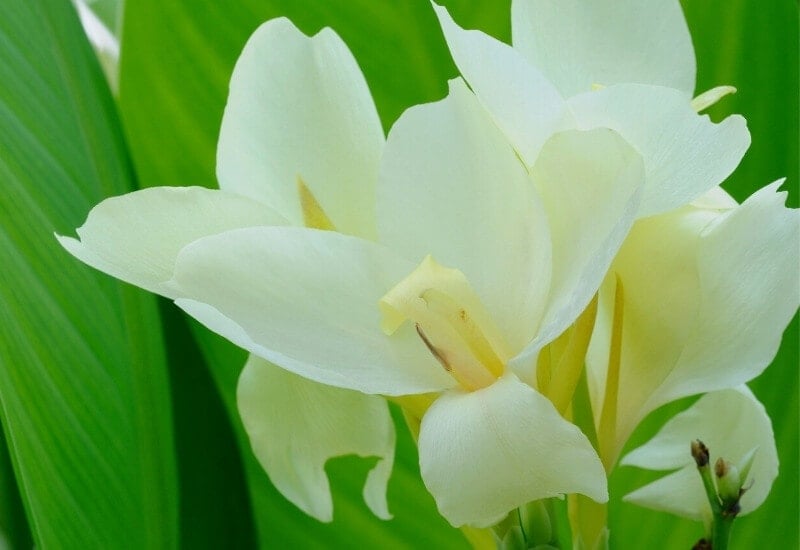
Another choice that will surprise your guests is a white canna lily. And there is one; it is called ‘Ambassadour’. Like all other canna lilies it has those beautiful, large, waxy leaves that, even without flowers, can turn any flower bed into a tropical oasis… Like other canna lilies it is tall and very showy.
Unlike other canna lilies, though, ‘Ambassadour’ does not have warm colored flowers… At the top of the tall and upright stems, in fact, you will find a spike ivory colored exotic flowers!
It is a fast growing plant that self propagates, so it is also ideal for a border that needs foliage, texture and also white flowers and fast…
10. ‘Mrs Sinkins’ Pink (Dianthus ‘Mrs Sinkins’)
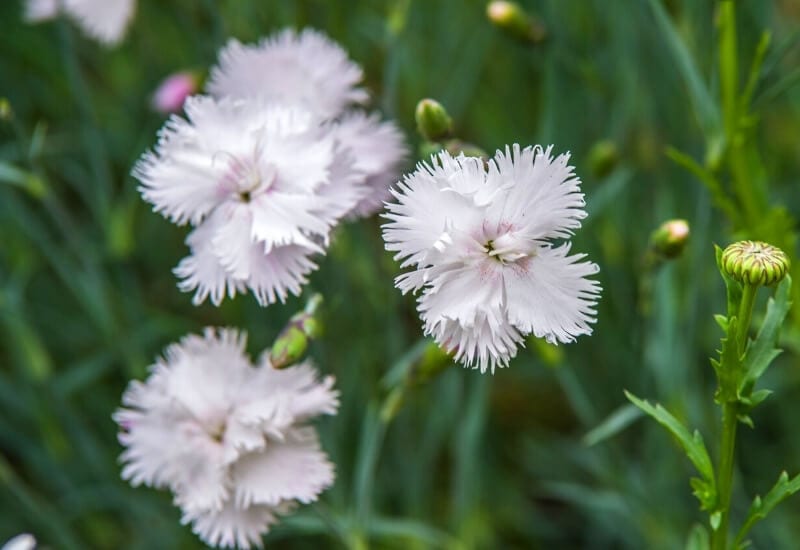
The white flowers of this heritage, actually historical carnation have one of the strongest, sweetest and most heavenly fragrances in the world. ‘Mrs Sinkins’ was is an all time favorite since it was introduced back in 1863. This small sized, carpeting pink will produce a sea of white flowers from spring all the way to fall, attracting butterflies and pollinators galore.
In flower beds, low borders, next to paths, but also in containers, this old world dianthus has adorned gardens for more than a century, with its blue foliage and snow-white flowers, but also with a scent that you can literally smell at a distance.
It is now rarer to find than it was a few decades ago, but if you do find it, do give it a place in your garden and you won’t regret it.
11. African Lily ‘Polar Ice’ And ‘Albus’ (Agapanthus ‘Polar Ice’ And Agapanthus Africanus ‘Albus’)
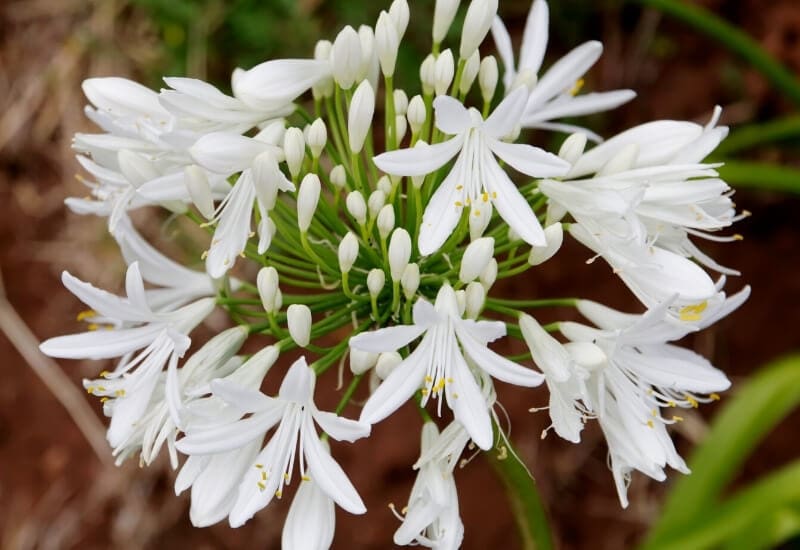
Most African lilies are blue to lavender, but there are white varieties too; ‘Albus’ and ‘Polar Ice’ will give you the large, globular inflorescences typical of this perennial, but in the brightest shade of white.
They look great in borders, beds and containers, and especially in gravel gardens, thanks to their upright stalk with the showy white “sphere” on top and their long, tongue like and fleshy leaves. In this color, they adapt very well to formal and contemporary gardens too.
‘Albus’ has a thicker inflorescence than ‘Polar Ice’ though. The choice is yours.
12. Peruvian Lily ‘Antarctica’ (Alstroemeria Inticancha ‘Antarctica’)
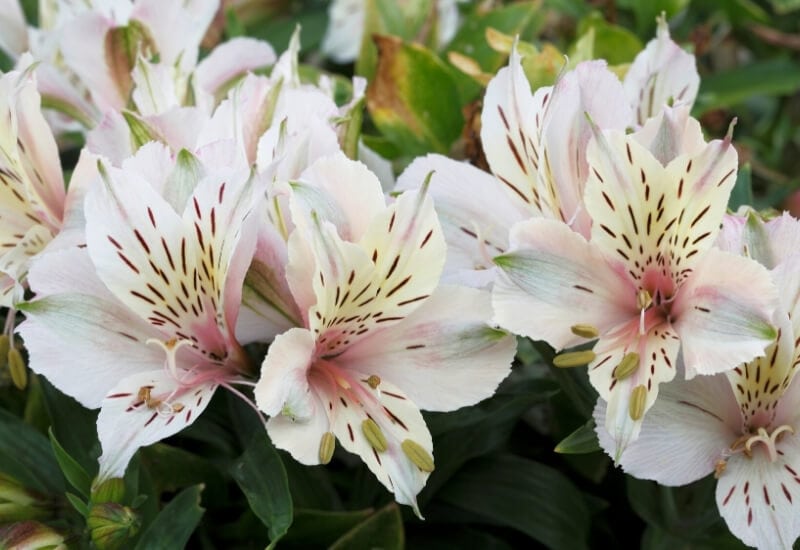
This is the first flower in the list that is not fully white, but its beauty and originality mean we cannot leave it out. Peruvian lilies are famous for their coral, red, orange, reddish and other sunny and warm colors. But as the name suggests, ‘Antarctica’ is white, which makes the burgundy streaks with a lemon yellow “haze” even more striking.
This is a dwarf variety, which will fit even in low beds, small containers or at the front of borders.
13. Japanese Anemone ‘Wild Swan’ (Anemone ‘Wild Swan’)
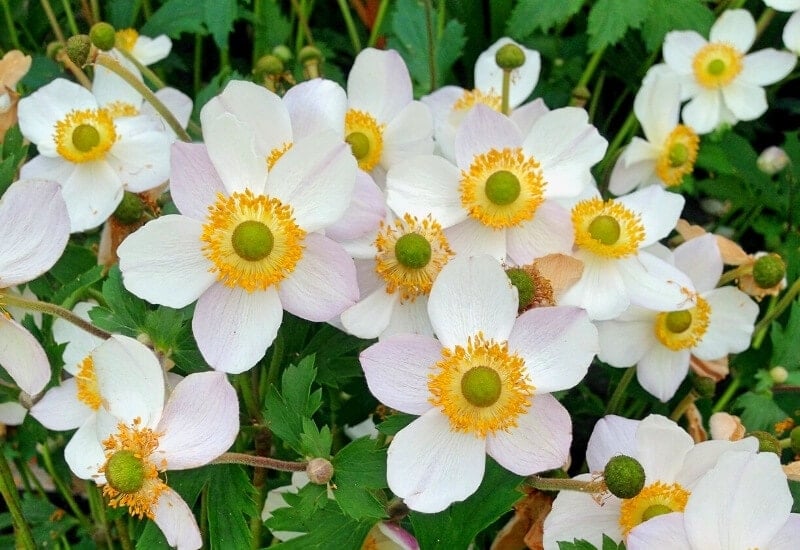
The flowers of this perennial are large for an anemone. They can reach 4 inches across (10 cm), which makes it stand out from other plants if this genus.
They will appear above the rich foliage with its intricate texture in abundance and for long. In fact, another exceptionality of this anemone is that it blooms from spring to fall!
The five petals are snow white with a central golden crown of pistils. At the back though, the petals have large lavender stripes. This is such a beautiful variety that it won the Plant of the Year Award at the Chelsea Flower Show.
14. Columbine ‘Songbird Dove’ (Aquilegia ‘Songbird Dove’)
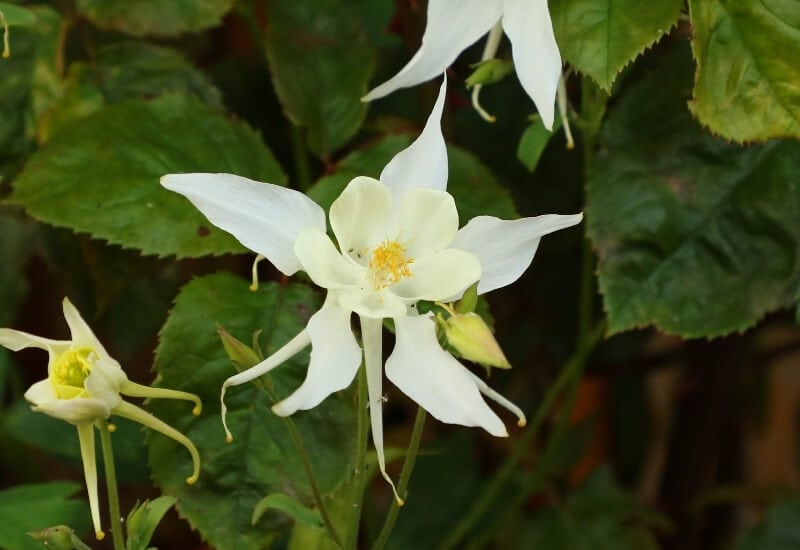
The beauty and originality of the columbine flower, with its complex shape is even more elegant in white over the lace-like foliage. And ‘Songbird Dove’ is of the most peaceful and candid white ever.
This winner of the Award of Garden Merit by the Royal Horticultural Society has a compact shape, which makes it ideal for borders, beds and pots that need filling with foliage. They white flowers though do provide an interesting contrast with the green leaves.
It is a short lived perennial, but it self seeds, so it will stay in your garden forever.
15. Water Arum (Calla Palustris)
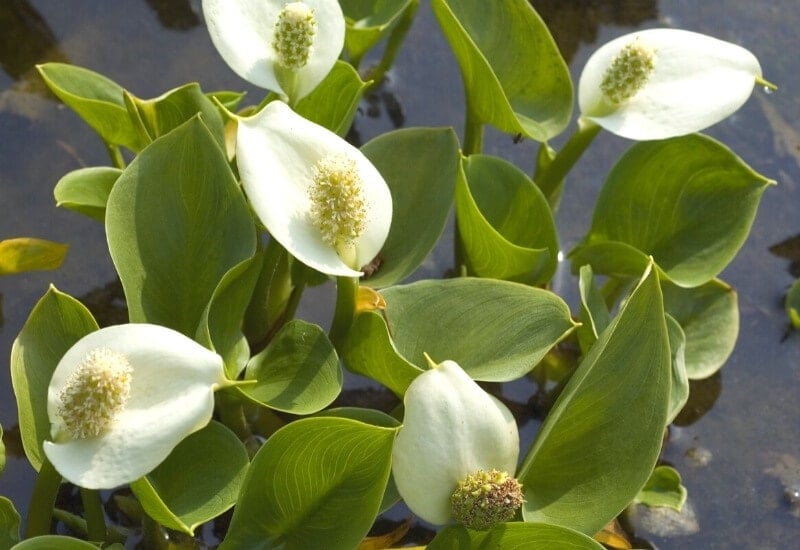
This perennial is exotic looking, with large upright and glossy heart shaped leaves that start from the base.
It will grow well next to ponds and rivers, even in wet soil and it will produce a long spadix of cream and green flowers, but what is most striking is the white spathe that surrounds them.
The beauty of this plant will continue even after blooming, when it produces bright red berries.
These characteristics make it a very useful plant in from spring to the first frost and it will form beautiful clumps thanks to its underground rhizomes. Although it is a garden plant. Which also propagates easily and spontaneously, its exotic appearance makes it look more like a houseplant..
White Snow Flakes in Your Garden
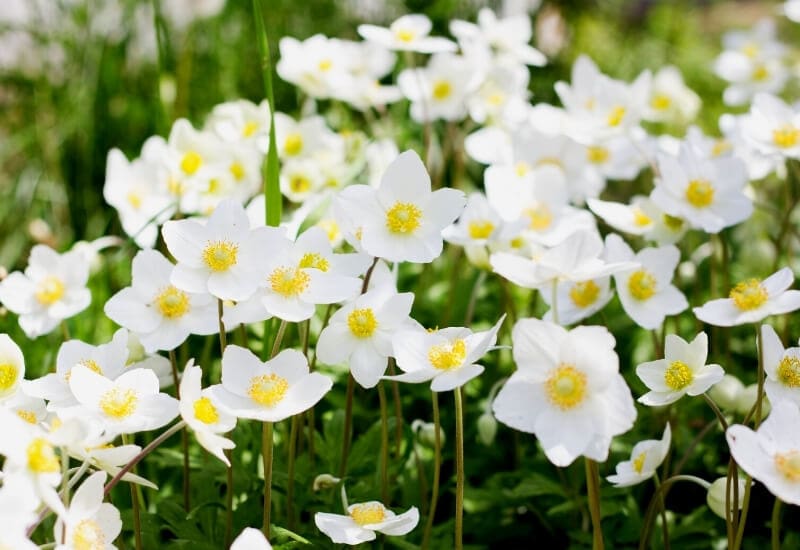
As you can see, perennials with white flowers have a very special beauty. White makes their flowers bright and elegant, but also sweet and innocent looking.
We have seen some classics like ‘Mrs Sinkins’, but this list has also given you a selection of some of the best white flowers for most types of gardens and places. From formal to informal gardens, from dry to boggy soil, from cold to warm places, there is surely a white flowering perennial that suits your needs.

Written By
Amber Noyes
Amber Noyes was born and raised in a suburban California town, San Mateo. She holds a master’s degree in horticulture from the University of California as well as a BS in Biology from the University of San Francisco. With experience working on an organic farm, water conservation research, farmers’ markets, and plant nursery, she understands what makes plants thrive and how we can better understand the connection between microclimate and plant health. When she’s not on the land, Amber loves informing people of new ideas/things related to gardening, especially organic gardening, houseplants, and growing plants in a small space.
